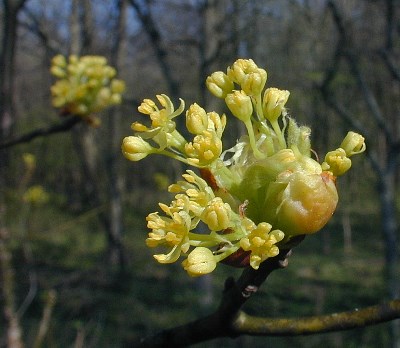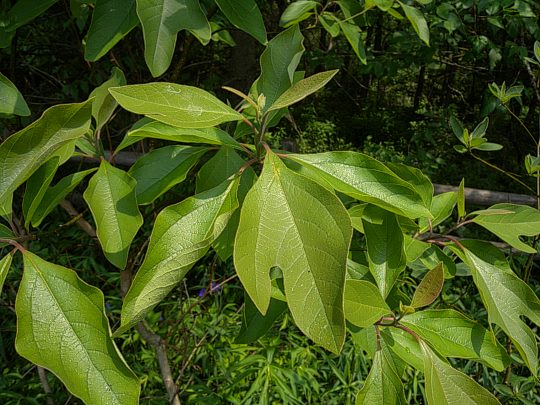Description: This tree is typically 30-60' tall with trunks 1-2' across, although specimens up to 100' with even wider trunks occasionally occur. The crown of each tree is roughly ovoid in shape with fairly short spreading branches. The trunk bark of older trees is gray-brown, irregularly furrowed, and rough, while the bark of large branches is similar, except more smooth. Small branches are greenish yellow or greenish brown, terete, and smooth with scattered gray lenticels, while newly developed shoots are pale green to greenish red, terete, and slightly pubescent. The alternate leaves develop from new shoots; they are up to 6" long and 4" across and either unlobed, two-lobed, or three-lobed. Unlobed leaves are ovate, while two-lobed leaves have one large lobe and a smaller side lobe resembling the shape of a mitten. Three-lobed leaves have a large central lobe and two smaller side lobes. All leaf lobes are slightly more long in length than they are across, and their tips are blunt or rounded. The leaf bases are usually wedge-shaped, although sometimes they are well-rounded. The upper leaf surfaces are medium green to yellowish green and glabrous, while their lower surfaces are pale green and glabrous to pubescent. The slender petioles are up to 1" long and light green to red.

The yellowish flowers bloom in tight clusters at the tips of twigs shortly before or during the early development of the leaves. Because Sassafras is dioecious, male and female flowers develop on separate trees. Individual male flowers are about 1/3" (8 mm.) across, consisting of 6 greenish yellow to yellow petaloid sepals and 9 stamens with yellow anthers. The sepals are oblong in shape. The inner 3 stamens have paired glands at their bases. Individual female flowers are about 1/3" (8 mm.) across, consisting of 6 greenish yellow to yellow petaloid sepals, a central pistil, and 6 small stamens (staminodia) that are sterile. The blooming period occurs during mid-spring and lasts about 2 weeks. Fertile female flowers are replaced by ovoid drupes about 1/3" (8 mm.) long that become dark blue when they are ripe. Each drupe contains a single seed. The drupes are arranged in corymb-like racemes up to 2" long. When the drupes are ripe, the pedicels become bright red; each pedicel develops a cup-like shape underneath each drupe. The root system produces widely spreading lateral roots that occasionally develop clonal offsets. During the autumn, the leaves acquire attractive coloration consisting of yellow, orange, or red.

Cultivation: The preference is full or partial sun, mesic to dry mesic conditions, and soil consisting of sandy loam. However, Sassafras also adapts to soil containing loam, clay-loam, or rocky material. Its growth and development is moderately fast, forming fruiting trees in about 10 years. The seeds require exposure to cold temperatures for 90-120 days before they will germinate. It is possible to propagate new trees from pieces of the lateral roots, particularly when they have above-ground shoots. Sassafras is allelopathic, releasing several compounds that inhibit the growth and development of neighboring plants.
Range & Habitat: The native Sassafras is a common tree that is found primarily in southern and central Illinois; it is absent to uncommon in the northern section of the state (see Distribution Map). There is some evidence that its range is expanding northward. Habitats include open woodlands and sandy woodlands, thinly wooded bluffs, typical savannas and sandy savannas, woodland borders, typical thickets and sandy thickets, stabilized sand dunes with woody vegetation, rocky glades, fence rows, powerline clearances in wooded areas, and abandoned fields. Sassafras is a pioneer tree that spreads to semi-open areas with reduced competition. In wooded areas, it benefits from wind-storms and ice-storms that knock over large canopy trees.
Faunal Associations: The nectar and pollen of the flowers attract a variety of insects, especially small bees and flies. More specifically, these flower-visiting insects include Halictid bees (Lasioglossum spp., Sphecodes spp.), Andrenid bees (Andrena spp.), Ichneumonid wasps, other kinds of wasps, various sawflies, march flies (Bibionidae), flower flies (Syrphidae), dance flies (Empis spp., Rhamphomyia spp.), Tachinid flies, blow flies (Calliphoridae), Muscid flies, flesh flies (Sarcophagidae), Anthomyiid flies, lesser house flies (Fanniidae), and various beetles (Robertson, 1929; Krombein et al., 1979; MacRae, 1991). Sassafras also attracts both oligophagous and polyphagous insects that feed on its leaves, sucks its plant juices, and bores into its stems and roots. This includes such insects as the larvae of the Sassafras Borer (Oberea ruficollis), both adults and larvae of the Yellow Poplar Weevil (Odontopus calceatus), larvae of the Sassafras Leaf Midge (Dasineura sassafras), a leafhopper (Eratoneura certa), larvae of the Sassafras Caloptilia Moth (Caloptilia sassafrasella), larvae of the Promethea Moth (Callosamia promethea), larvae of the Labyrinth Moth (Phaecasiophora niveiguttana), and larvae of a butterfly, the Spicebush Swallowtail (Papilio troilus). See the Insect Table for a more complete list of these insect feeders. The fruits of this tree are eaten by many species of birds, including the Eastern Towhee, Northern Mockingbird, Yellow-throated Warbler, Pileated Woodpecker, Bobwhite Quail, Veery, Grey-cheeked Thrush, Eastern Phoebe, and White-eyed Vireo. The Bird Table provides a more complete list of these species. White-tailed Deer browse on the leaves and twigs of Sassafras, while the Cottontail Rabbit feeds on the bark, buds, and twigs of the saplings of this tree during the winter (Sotala & Kirkpatrick, 1973; Martin et al., 1951/1961; Haugen, 1942). Sassafras also functions as a roost tree for the Northern Long-eared Bat (Myotis septentrionalis); both maternal colonies and male bats use this tree for this purpose during the summer (Johnson et al., 2009; Ford et al., 2006).

Photographic Location: The photograph of the male flowers was taken during the spring in a woodland opening in east central Illinois, while the remaining photographs were taken of a tree that was located at the edge of a woodland in Vermilion County, Illinois.
Comments: Sassafras is a wonderful tree that produces flowers early in the spring and it has oddly shaped leaves that assume attractive colors during the fall. If the bark of young smooth branches is scratched, it releases an attractive spicy odor. The roots of Sassafras have been used in making tea and flavoring root beer, but there is some evidence that it may be carcinogenic. Because of its distinctive leaves and aromatic greenish branches, Sassafras is easy to identify in the field. It is related to the smaller Lindera benzoin (Spicebush), which has unlobed leaves and small red fruits.